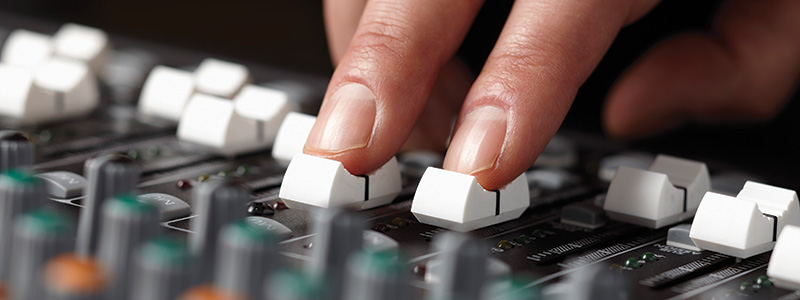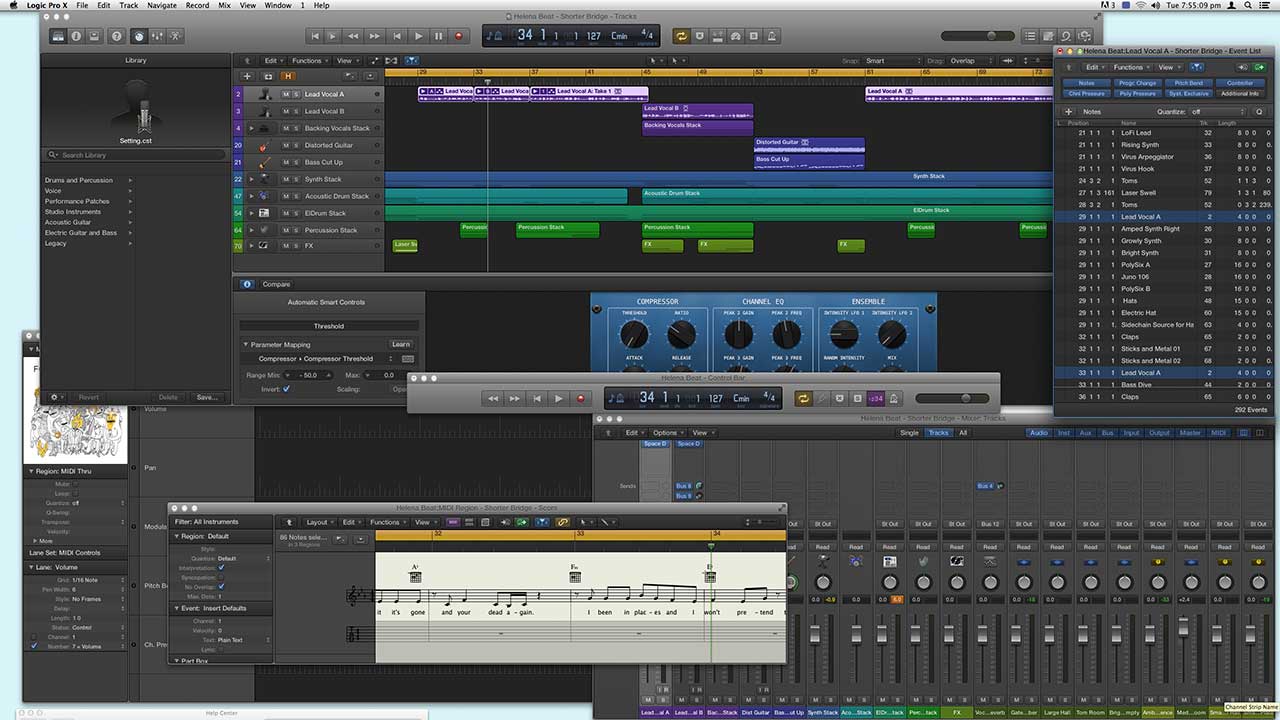
[Editor’s note: this is part of a series of articles about home recording. At the end of this article are links to other articles in this series.]
If you’ve ever tried to imagine what it’s like to be at the helm of the Starship Enterprise, then sitting in front of a large-format mixing desk will probably give you a glimpse of that feeling!
All of those knobs, buttons, faders and switches translate into you having detailed control over every aspect of the sound you hear. If you think that a mixing desk is impressive, then you’ll be blown away by what you can do with a Digital Audio Workstation (DAW).
For the vast majority of home studio owners, the DAW software is the control center of their studio. The DAW is the program that allows you to create, record, edit and arrange audio.
What makes a DAW?
When you hear the term Digital Audio Workstation, it typically refers to a software application such as ProTools, Logic or Sonar. Most DAWs are based on a multitrack tape recorder and mixing desk metaphor. The primary working views are:
- Horizontal multi-track lanes of audio mimicking how multitrack audio lined up on 2” tape
- A virtual mixing desk.
 DAWs come in many shapes and sizes, but, for the most part, all have similar elements:
DAWs come in many shapes and sizes, but, for the most part, all have similar elements:
- Transport controls: Play, Record, Loop, Rewind, etc.
- Track controls: track volume, track panning (stereo balance), solo, mute
- Track editor: lets you examine and edit individual audio and MIDI tracks
- Audio routing and processing: the ability to route audio to internal or external processing in real-time.
- Plug-ins: virtual audio processing units (like EQ, compressors or reverb) or MIDI-based instruments that can be used to interact with the DAW.
- Automation: the ability to record and edit time-based adjustments to multiple parameters (such as volume fades and stereo pan changes) in the DAW
- Synchronization: most DAWs will allow you to synchronize with other audio or video media
- Cut, Copy, Paste, Undo: DAWs allow you to perform functions that are common to office automation applications
There are a lot of other functions you’ll probably find implemented across DAWs, but that should give you a list of the usual suspects.
Before You Dive In
I won’t sugarcoat it for you: DAWs are complicated. You will be investing a lot of time and patience in order to become proficient at using the software. Selecting the right one for you is not going to be a simple task either – you may need to try out a few before you settle on one you like. In fact, I encourage you to do this!
Now, if you’ve already done some research and started to get your feet wet, then great! Diving in and trying things out is a fantastic way to learn. You’ve probably also found that there are a LOT of options – not only within the DAW you’re using, but also between the DAWs.
Selecting a DAW can be a lot like buying a car. They all pretty well do the same thing, but there are functional and design differences that will determine whether it fits or doesn’t fit with the way you work. Some DAWs are more complex than others and there are some that are designed with more specific functions and workflows in mind.
That Question Again
 How will you know which DAW is best for you? I’m going to begin the broken record trend and bring up a point from my last post. You need to ask yourself:
How will you know which DAW is best for you? I’m going to begin the broken record trend and bring up a point from my last post. You need to ask yourself:
How are you going to be using your studio?
Let’s get started:
- What do you feel is your ultimate goal? Whether you’re recording yourself for fun, family and friends or have aspirations to release an EP on iTunes in your home studio will weigh on your decision.
- How do you like to learn? You may be like me and like to dive into the deep end – get your hands dirty trying everything out by yourself and have the manual ready when you get stuck. On the other hand, you may be one who likes to take the logical step-by-step approach – start off simple and increase complexity when comfortable.
- What is your budget? There’s no denying it, this is a major decision point. Fortunately, unlike the automobile metaphor, the price of a DAW does not correlate with quality, functionality or amount of options.
I’ll freely admit it, I’ve gone through many DAWs over the years before settling on my current setup. I started off with Cakewalk Pro Audio (that will date me), moved to Cubase, came back to the Cakewalk family with Sonar and then switched platforms to end up with Logic for the past six or seven years.
The point is that you shouldn’t agonize too much over your decision. Also, don’t feel obligated to make a decision too quickly. Kick some tires and try out a few different flavours:
- Many DAWs have demo versions – download them and try them out.
- Search for reviews and opinions of DAWs you’re considering.
- Watch a few video tutorials introducing the product – YouTube is a fantastic resource for this!
The Lists
I’ll leave you with a few suggestions to get you started – starting off with some DAWs for the home recordist who wants to take things slowly.
![]() If you don’t have a Mac, then unfortunately, you’ll have to pass on this suggestion. This application has been around for about a decade and has evolved into quite a robust DAW. It’s not as feature-rich as its big brother, Logic, but it packs a lot of features. The developers at Apple have gone through a lot of trouble to design Garageband to not intimidate beginners, but allow users to dive into more complex recording and mixing techniques as their knowledge and confidence grow
If you don’t have a Mac, then unfortunately, you’ll have to pass on this suggestion. This application has been around for about a decade and has evolved into quite a robust DAW. It’s not as feature-rich as its big brother, Logic, but it packs a lot of features. The developers at Apple have gone through a lot of trouble to design Garageband to not intimidate beginners, but allow users to dive into more complex recording and mixing techniques as their knowledge and confidence grow
![]() This is probably the closest thing you’ll find to Garageband on the PC. Like Garageband, Mixcraft packs a lot of functionality into a package that focuses on not intimidating folks who want to ease into multitrack recording. All the basics are covered and when you want to dive down to the next couple of layers, they’re available to you.
This is probably the closest thing you’ll find to Garageband on the PC. Like Garageband, Mixcraft packs a lot of functionality into a package that focuses on not intimidating folks who want to ease into multitrack recording. All the basics are covered and when you want to dive down to the next couple of layers, they’re available to you.
![]() Like Mixcraft, Music Creator is for the PC and is designed to be easy to use. It shares a lot of the look and feel from its bigger brother, Sonar, so if you do start on Music Creator and want to jump to something with more features, then the switch will have some familiar User Interface elements to it.
Like Mixcraft, Music Creator is for the PC and is designed to be easy to use. It shares a lot of the look and feel from its bigger brother, Sonar, so if you do start on Music Creator and want to jump to something with more features, then the switch will have some familiar User Interface elements to it.
![]() FL Studio got its start as a kid-friendly application called “Fruity Loops”. It has evolved into a feature-rich DAW that still has strong ties to its origins. Its layout is a bit different than other DAWs but for some people, it makes sense. I’ve not used it, but have seen people compare it to Ableton Live which is a DAW designed to facilitate live performances and electronic music production.
FL Studio got its start as a kid-friendly application called “Fruity Loops”. It has evolved into a feature-rich DAW that still has strong ties to its origins. Its layout is a bit different than other DAWs but for some people, it makes sense. I’ve not used it, but have seen people compare it to Ableton Live which is a DAW designed to facilitate live performances and electronic music production.
Diving In
For those who want to get right into the meat and potatoes of the DAW world, here is a selection of some of the powerhouses out there.
![]() An article on DAWs would be severely remiss without mentioning ProTools. There’s no denying that ProTools is the most referred-to DAW on the market. That being said, it’s not for everyone. It’s a full-featured application that is cross-platform (Mac and PC) and enjoys a large user-base. Its strength lies in audio-recording and audio routing. You’ll most likely find a copy of ProTools installed in a healthy majority of large professional studios out there. Best Buy carries Avid ProTools – check out more about this DAW here.
An article on DAWs would be severely remiss without mentioning ProTools. There’s no denying that ProTools is the most referred-to DAW on the market. That being said, it’s not for everyone. It’s a full-featured application that is cross-platform (Mac and PC) and enjoys a large user-base. Its strength lies in audio-recording and audio routing. You’ll most likely find a copy of ProTools installed in a healthy majority of large professional studios out there. Best Buy carries Avid ProTools – check out more about this DAW here.
![]() Like Garageband, Logic is only available on the Mac. It is a robust DAW with all the tools and functions you need to record and mix audio. If ProTools is the first to come to mind for recording, Logic is typically the first for songwriting and production. It boasts a long list of effects, instruments and additional media that make it a snap for you to start creating.
Like Garageband, Logic is only available on the Mac. It is a robust DAW with all the tools and functions you need to record and mix audio. If ProTools is the first to come to mind for recording, Logic is typically the first for songwriting and production. It boasts a long list of effects, instruments and additional media that make it a snap for you to start creating.
![]() The Cakewalk line has a very long lineage in computer-based music production. With its start back in the late 1980’s (and a few name-changes), Cakewalks’ flagship DAW has evolved into a front-runner in the PC-based DAW market. Sonar comes packaged with a lot of great professional-grade audio plugins and software instruments. Best Buy carries all three versions of the Cakewalk Sonar line: Basic, Studio and Producer.
The Cakewalk line has a very long lineage in computer-based music production. With its start back in the late 1980’s (and a few name-changes), Cakewalks’ flagship DAW has evolved into a front-runner in the PC-based DAW market. Sonar comes packaged with a lot of great professional-grade audio plugins and software instruments. Best Buy carries all three versions of the Cakewalk Sonar line: Basic, Studio and Producer.
![]() Reaper can be considered to be the maverick rebel of the DAW market. It was started by indy developers in the early 00’s and, to this day, boasts an extremely efficient code-base. It’s one of the only DAWs I know that can be shuttled around on a USB drive. The UI is not as slick as some of the others out there, but Reaper packs a lot of features! Its speed, customizability and low price have made it a go-to choice for many in the DAW market.
Reaper can be considered to be the maverick rebel of the DAW market. It was started by indy developers in the early 00’s and, to this day, boasts an extremely efficient code-base. It’s one of the only DAWs I know that can be shuttled around on a USB drive. The UI is not as slick as some of the others out there, but Reaper packs a lot of features! Its speed, customizability and low price have made it a go-to choice for many in the DAW market.
![]() Live is an anomaly when compared to other DAWs. The UI and workflow is not designed specifically around the mixing desk / multitrack tape paradigm. Live came out of the emerging laptop musician trend that started over a decade ago. It facilitates an intuitive drag-and-drop method of sequencing audio clips. It’s strength lies in allowing users to perform their multi-track creations live using Live’s intuitive non-linear playback and real-time editing.
Live is an anomaly when compared to other DAWs. The UI and workflow is not designed specifically around the mixing desk / multitrack tape paradigm. Live came out of the emerging laptop musician trend that started over a decade ago. It facilitates an intuitive drag-and-drop method of sequencing audio clips. It’s strength lies in allowing users to perform their multi-track creations live using Live’s intuitive non-linear playback and real-time editing.
So, so many more…
There are so many more options that you can choose from. I unfortunately don’t have the time or space to cover all of the other options available. In order to stave off the inevitable “you forgot about…” feedback I’ll get on this post, I’ll end with a (non-exhaustive) list of other DAWs that you want to look into as well:
- Propellerheads Reason
- Presonus Studio One
- Steinberg Cubase
- MuTools MuLab
- Magix Samplitude
- Renoise
- Harrison Mixbus
- Ardour
- Sony Acid
As always, I invite your feedback and comments. Please feel free to drop me a note in the comments of this post or get in touch with me via the social media links below. Until next week!
| What Gear Do I Need? |
Learn About Audio Interfaces |
Learn About Microphones |
Here is a link to all the articles in the home studio series The Soundboard.



